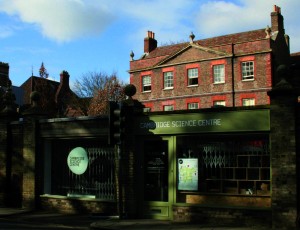WEDNESDAY, 15 MAY 2013
Cambridge has a reputation as a world-class centre for excellence in scientific research and some of the most significant discoveries in modern times have been made here. It therefore seems obvious that as a city we should seek to inspire younger generations to explore science and make their own discoveries about how things work in the world around them. However, unlike many other cities we have never had a dedicated hands-on science museum providing these opportunities. The opening of the new Cambridge Science Centre has changed all that. Open six days a week, the Science Centre is filled with a fascinating array of hands-on exhibits ranging from infrared cameras to giant anatomical models, and also features a large magnetic wall on which complex cog and gear contraptions can be constructed.The Cambridge Science Centre first burst on to the scene in October 2011, staging a one- day ‘Science Xchange’ event at the Cambridge Guildhall. The event featured scientific artwork, guest demonstrations by student society CHaOS and the main attraction, a ‘Rube Goldberg’ machine made up of interconnecting modules, manufactured by science centre staff and groups of local schoolchildren. Each module was made up of moving parts, which tipped, dropped or sprang to trigger movement in the next section, creating a chain reaction that travelled around the room and culminated in the firing of a high-speed air rocket the length of the hall to release squealing balloons. The event was such a hit that the ‘Science Xchange’ returned to the Guildhall in October 2012, with members of the public adding to the mayhem by building contraptions on the day. This time, the chain included dominoes, hydraulic systems, catapults and a fantastic musical organ constructed from mouse traps and party poppers.
Between these two events, the Cambridge Science Centre team were hard at work taking their unique hands-on exhibits further afield across Cambridgeshire. The ‘Library Science Lab’ tour in summer 2012 saw interactive stations, featuring equipment from microscopes to electromagnetic generators, installed in public libraries across the county. The tour proved to be a great success, receiving excellent feedback, and soon after completion the first full-time home for the Cambridge Science Centre was confirmed: the old Marshall’s Garage workshop on Jesus Lane. The opening of the Science Centre in early February was the culmination of many months of hard work by a small but dedicated team of science communication enthusiasts. This hard work proved worthwhile; the venue was packed with excited visitors throughout lent half-term. School groups will be able to book to visit the centre on weekday mornings, while during afternoons, weekends and school holidays the centre will be open for the public to drop in or attend a variety of scheduled workshops. Special events, including those aimed at adults, will also run in the evenings.
Despite the small size of the centre, it is crammed with a range of exciting exhibits, which will change on a regular basis, making repeat visits worthwhile. The centre is well worth exploring whatever your age or background, and in addition will provide excellent opportunities for both volunteering and employment in the field of science communication. Visit www.cambridgesciencecentre.org to find out more, or follow @camsciencecntr on Twitter for regular updates on the progress of new exhibits in the workshop!
Elizabeth Mooney is a 2nd year PhD student at the Department of Pharmacology

